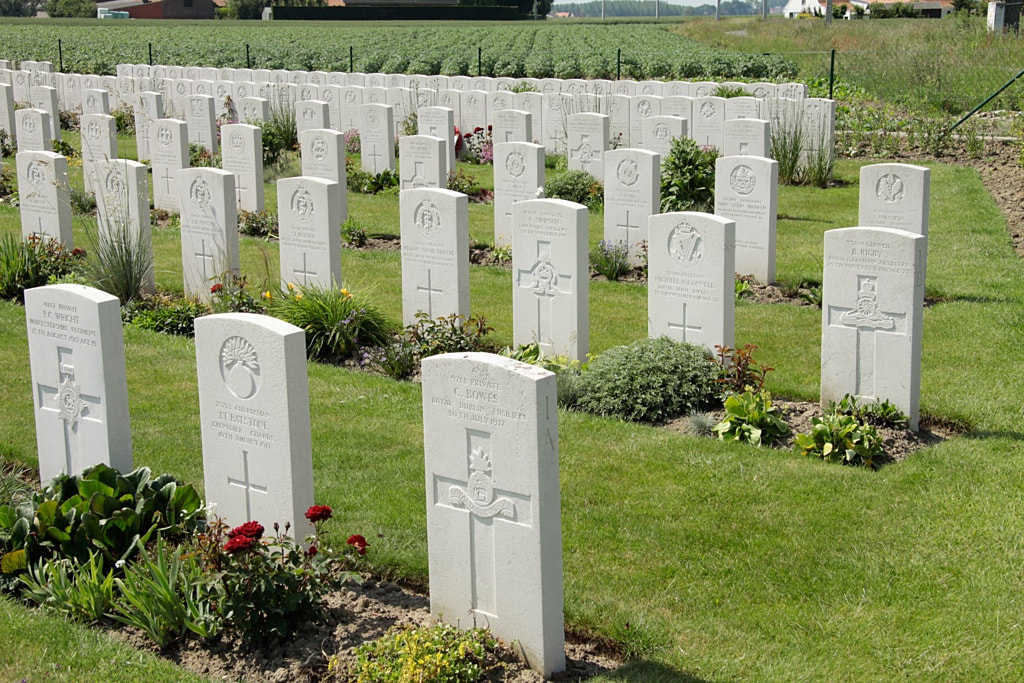Walter Williams
Date of birth: 1889
Date of death: 20.04.1918
Area: Outwood, Wakefield
Regiment: Duke of Wellington’s
Family information: Husband of Harriet Emma Williams nee Aveyard
Rank: Lance Corporal
Service number: 307887
War Service
When war was declared Walter Williams joined the Duke of Wellington’s (West Riding Regiment). He was attached to the 1/7th Battalion, part of 2nd West Riding Brigade. On 14th April 1915 the 1/7th Duke of Wellingtons, in Division, landed in France to join the British Expeditionary Force. A month later the formation was renamed the 147th Brigade, 49th (West Riding) Division.
The 49th Division was not involved in any major attacks during 1915 but served on the front line and incurred many casualties. In December 1915 the Division was in the Ypres Salient, between Frezenburg and Boesinghe when the German artillery bombarded the front line with gas shells, which for the first time contained Phosgene. The British gasmasks were found to be ineffective against high levels of Phosgene and many troops died within twenty-four hours after exposure to the gas.
On 23rd March 1916, when home on leave, Private Walter Williams of the 49th Division Cycle Company married Harriet Emma Aveyard of Greenfield Place, at St Mary Magdalene Church, Outwood.
The Battle of the Somme began on 1st July 1916 and on the following day the 1/7th Duke of Wellington’s relieved the 1/5th West Yorks in the Thiepval sector. The 1/7th Battalion remained in the line for seven weeks and incurred about 350 casualties. After a short break the 1/7th Duke of Wellington’s returned to the front line and remained on the Somme until the battle came to a close, in November 1916. Shortly afterwards, on the 14th December 1916, his daughter Olive was born.
In July 1917 the 49th Division took over the Nieuport sector on the Belgian coast. At midnight on 21st July the enemy bombarded the front line with mustard gas shells. The town of Nieuport was drenched in gas and many troops stationed there became casualties. Shortly afterwards the 49th Division moved down the coast to prepare for Operation Hush, a two pronged attack, by sea and along the coastal strip, towards the port of Ostend. However the operation was cancelled and, on 9th October, the 49th Division was deployed to the attack at Poelcapelle, during the third Battle of Ypres.
On 9th April 1918 the German Army launched its second major offensive of the year. On this occasion along the Lys valley, towards the important railway town of Hazebrouck. The 49th Division moved south from the Ypres Salient and was soon involved in the fighting at Estaires and Messines. Early on the 14th April the enemy forced their way into the village of Neuve Eglise, but was driven out by troops from the 33rd and 49th Divisions. There was heavy fighting throughout the day and during the night the British withdrew to the high ground, between Bailleul and Neuve Eglise. Fighting continued the next day, the 15th April, but late in the afternoon Bailleul fell to the enemy. During the days that followed the 49th Division, along with the 25th and 34th Divisions, formed a defensive line between Meteren and Wytschaete. Here they became continually involved in heavy fighting, as the enemy attempted to take Mount Kemmel.
On 15th April the 147th Brigade occupied the Corps Reserve line at St Jans Capelle, but during the following day these positions became the front line. The 1/7th Duke of Wellington’s was in Brigade reserve, but came under enemy shelling, which was particularly heavy between 19.30 and 21.00 hours. However no infantry attacks followed this shelling and casualties were light, the 1/7th Battalion having incurred only 3 casualties.
It was about this time that Lance Corporal Williams was injured and taken to the Casualty Clearing Station at Haringhe, better known as Bandaghem. However on 20th April he died from his wounds and was buried in the nearby cemetery. The Haringhe (Bandaghem) Military Cemetery contains 772 Commonwealth burials and 39 German burials from the First World War.
Family Life
Born in 1889, Walter Williams was the first child of Arthur Joseph Williams and his wife Esther, nee Dixon, of Green’s Place, Newton Lane, Outwood. His father was a coal miner, but later became a Colliery Deputy, at which time the family moved to Newstead Terrace, Outwood. On leaving school Walter Williams was employed in the Engineers Department at Lofthouse Colliery. In 1908 his father died and shortly afterwards his mother and her three children moved to Lawns, at Outwood. At the time of the 1911 census Walter was working as a fitter at the colliery.
 Haringhe (Bandaghem) Military Cemetery
Haringhe (Bandaghem) Military Cemetery

